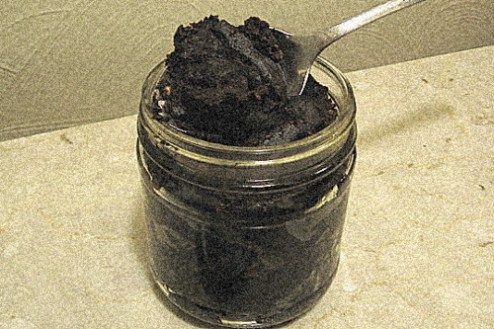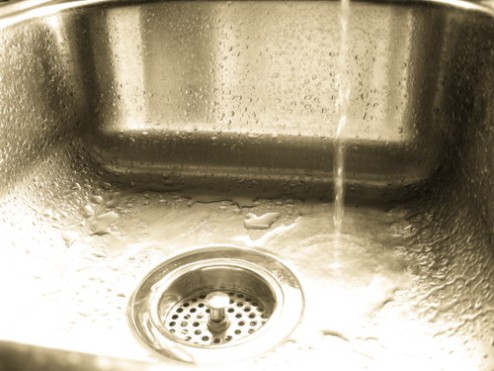Nam Prik Pao
Or, dry-roasted chile-water. Except that, over several generations of cooks in Thailand, it became customary to deep-fry the ingredients before pounding them to a paste instead of dry-roasting them. Still, the old name remains…but, to tell you the truth, I have noticed a trend within the last few years of a nod backward to that old, oil-less method, which in turn is used to produce an equally oil-free version of one of my most favorite dishes, kaeng thom yam…
Luckily, I was well-spoilt on the oily classic before that lack-lustre, long-cloistered twin came out of hiding, and scoff and jeer at it side-by-side-and-arm-in-arm with stubborn Thais who also refuse to accept it as worthy of bearing the same surname. No, give me my perfect pools of red-kissed oil floating dreamily across the surface of my thom yam, fragrant and infusing the broth with oily-rich, brown flavours that cling to my tongue and lips like luscious liquid lava!
Though… this chile-water (excuse me, I need to wipe my mouth after that last paragraph) is used to season other dishes as well, and is also a condiment in its own right: like other chile-waters, it pairs amazingly-well on a platter with raw vegetables, grilled meats or fish, and balls of rice.
This particular recipe I have taken, with minor adjustments, from the book, Cracking the Coconut, by Su-Mei Yu- without a doubt one of the best volumes ever written on classic Thai cooking, and I do recommend it to anyone interested in a concise, detailed and extremely well-researched treatise on the subject. (And yes, to keep pace with the growing trend both here in the West and in her homeland, she provides vegan alternatives within many of the foundation recipes).
Nam Prik Pao
3/4 C vegetable oil (coconut oil is traditional, but other oils, such as peanut, are also fine)
1 C dried shrimp
1/2 C thin slices of garlic
1 C thin slices of shallots or onions
1 1/2 C torn, mostly-seeded pieces of clean, dry red chiles (I used a mixture of hot and medium-hot chiles)
1/3 C palm sugar, or other brown sugar
1/4 C thick tamarind extract
1/3 C nam pla (fish water/sauce)
2 T kapi (fermented shrimp paste)
0)Wrap the kapi in a small envelope of banana-leaf, parchment-paper, aluminum foil, or soaked corn-husk . Grill in a dry pan set over a medium flame, flipping now and then, for 6-10 minutes- until a pleasant charred flavour emanates. Remove packet and set aside to cool.
1)Rinse the dried shrimp just briefly in cool water; drain well.
2)Heat the oil in a wok over medium-low flame, add the shrimp and fry, stirring constantly, until browned and crispy; remove from the oil to drain, recapturing the oil if possible to add back into the pan.
3)Do the same separately with the garlic, shallots (these should be fried on high heat in the beginning, turning it down as they progress to brown), and chiles (just until a shade darker- 1 minute or so), in that order. Remove the pan from the heat for the moment.
4)Pound, using a mortar-and-pestle, or process, using an electric grinder, these fried ingredients to a paste, again starting with the dried shrimp and continuing in the same order, adding the next only when the previous has formed a smooth paste.*
5)Mix in the sugar, then the tamarind paste and fish sauce; unwrap the kapi, add and blend well.
6)Heat the wok- with the remaining oil (you should have about 1/4 C left; add more if necessary)- over medium heat; add the paste and fry, stirring constantly, until mixture begins to move in one mass and oil can be seen at the edges. Remove from heat and allow to cool, then place mixture in a clean, dry jar and cover tightly. Always use a clean, dry spoon to extract amount required.
*If using coconut oil as a cooking-medium in conjuction with an electric grinder, it is helpful to heat the tamarind-paste and fish sauce before adding to keep the machine running smoothly, lest the fat solidify.



Anita said,
February 1, 2008 at 9:25 AM
Yay! Good Morning! You are alive and kicking! 😀
And nam prik pao has quite some kick, I can tell. I have a feeling there is more coming. I’ll keep this ready meanwhile…(will have to omit the dried shrimp though 😦 but shrimp paste I have).
Well, it’ll have to do! Honestly, though…the first time I made this was a vegan version and it was just as delicious! (Well, almost!)
musy said,
February 1, 2008 at 4:30 PM
Hi Pel, good one. A real hot dish, i must say! Now tell me the replacement for shrimp and kapi 🙂
Chilies are always good, fresh, dry, roasted, fried-any way you take them 😀
You can replace the dried shrimp and shrimp-paste with red miso (or skip them altogether- I’ve had it this way- it’s good), the nam pla with soy sauce…yes, it IS hot!
Anita said,
February 5, 2008 at 10:18 AM
That is much drier than I imagined…
(Sink?! 😆 Not after having a taste of this!)
A little light-headed? 🙂
Anita said,
February 12, 2008 at 10:58 AM
I made this tonight! And it is like nothing I have made before! It is out-of-this(my)-world! Amazing…almost like the mole of my dreams! Took a while since I was making the soup as well. That turned out fantastic! Thanks, Pel! [bows]
Rather like a paste-like oily achaar is it not? I’m so glad you enjoyed it…it is a must-have, essential Thai dish that, since I first tasted it, have been unable to live long without! The stew/soup that is…but the paste is good as a dip for raw veggies and balls of sticky rice as well…
These are a few of my new favourite things…. « A Mad Tea Party said,
May 26, 2008 at 11:11 AM
[…] (Elaichi et Cetera) scintillating Thai soup Kaeng Thom Yam, and Nam Prik Pao, the secret paste behind […]